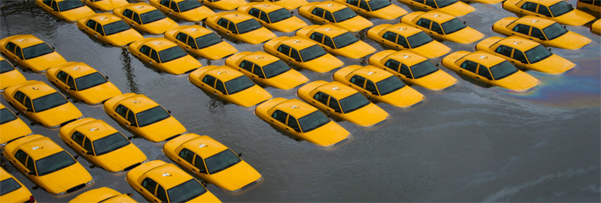or, The Resilient Thickness of Animal Architecture
E.M. Dodington
Like many of us I watched with heightened anticipation as Hurricane Sandy strengthened, diminished and then strengthened again as she made her way towards the east coast of the United States. As a native New Yorker currently residing in Houston, I felt that I had a unique brand of kinship with those in the event’s path. As a kid I had lived through a few scary North-Eastern storms and in recent years I had witnessed and become accustomed to a certain amount of natural-disaster on the hurricane-prone gulf-coast. But it was not so much that I had advice or tips for disaster-preparedness for my northeast kin, but a sense of shared anxiety. The images from the storm were jaw-dropping and the reports of damage done are stunning to say the least. Frantic phone calls were made and amazing stories of storm-wrought mayhem were retold. All of it was scarily familiar and doubly unbelievable. Two months since the storm, and I’ve just returned from my bi-yearly pilgrimage back to NYC to visit friends and family, and while I am deeply aware of the damage done and the lives lost I was reassured by the resilience of the city and the ability for much of life to regain normalcy. But the questions remain; How does a city of 8-million-plus prepare for future Hurricanes? What are the roles of architecture and urban planning in such circumstances? And the inevitable debate about rebuild vs. not rebuild…
I’ve been following a few of the stories in the news – media. Some of these discussions are included here in the links below, the New York Times revisits the Rising Currents Exhibtion, and Kate Orff (an exciting landscape architect in NYC, one of the original participants in Rising Currents, and an Animal Architecture Awards Jurist) is interviewed by ABC. ArchRecord, the AIA, Habitat for Humanity – they all offer their guidance and opinions on Sandy. One discussion however, that is not happening, that is not being included is the role and participation of our urban co-habitants – where’s Habitat for Animality? And not to sound too much like the Lorax here but, I feel strongly that is it time to include the non-human animals in this discussion.
I should mention here that this is not for animal-right’s sake per se. It’s not that I don’t feel strongly about protecting and increasing the rights of animals in general, and it isn’t for example that I feel the sea-gulls’ needs and views aren’t being properly addressed (which may be the case by the way). This is from a purely “we’re all in this together” attitude.
So you ask, how could animals possibly be of help? Well, Kate Orff’s Oyster-tecture, is a good start and a great example of how Humans and Non-human animals can work together for mutual benefit. But there are many others. In the nearly four years that I have been managing, writing and editing Animal Architecture.org I have come to see again and again that a greater partnership with our synanthropic animal-cohorts has an amazing potential to greatly benefit our human living situations, on the coast or off. In general, the strategy for including non-human animals into the discussion of urbanism and architecture boils down to an argument for a thick, resilient and a thriving heterogeneous ecosystem.
Below there are several key projects from Animal Architecture, real and imagined that have significant potential to thicken our urban ecologies and mitigate natural disasters. I have also included several of the larger stories from major media outlets regarding Hurricane Sandy. It is my hope that the combined readings will open up a greater discussion of the benefits of cross-species collaborations in architecture and urban planning.
Sincerely,
E.M. Dodington
Above image credit: The New York Times
Projects on Animal Architecture
The Terroir; Oyster reef remediation on Galveston Island
Oyster Tecture: Oyster reef flood-prevention in Manhattan
The Truffle: A cow makes a home for humans
Oil Eating Animals: Tube worms that eat polution
Animal Estates: The co-species cohabitation projects of Fritz Haeg
News Media:
Kate Orff on ABC
http://abcnews.go.com/US/video/landscape-designer-kate-orff-shares-vision-revitalized-york-17857567
Bracing for Change, ArchRecord:
“But buildings don’t exist in a vacuum, and the solutions individual properties choose to implement will also be determined by post-Sandy codes that municipalities enact, and the infrastructure investments that New York and New Jersey make—such as in seawalls, storm-surge barriers, engineered sand dunes, and improvements to the electrical grid.”
http://archrecord.construction.com/news/2012/12/121217-Bracing-for-Change.asp
Rising Currents Revisited, ArchRecord:
“The first step is to break down the mentality that has to do with installing one big sea wall,” says Adam Yarinsky, a partner at Architecture Research Office (ARO) in New York whose ideas led to the “Rising Currents” exhibition. “We do not need one storm surge barrier—it won’t protect the whole city anyway. I hope Sandy is a wake-up call. It is prefiguring what is to come. We need to be planning long-term.”
Hurricane Sandy, ArchRecord:
http://archrecord.construction.com/news/hurricane-sandy/
http://archrecord.construction.com/news/2012/11/121119-Storm-Surge-Barriers-Work.asp
Protecting New York City before next Time, New York Times:
“But some experts in the field who have thought deeply about how to protect New York from huge storms like Hurricane Sandy — and especially from the coastal surges they produce — suggested that less intrusive forms of so-called soft infrastructure might prove more effective in sheltering the city than mammoth Venetian sea walls. Mayor Michael R. Bloomberg seemed to agree with them on Thursday when he said: “I don’t think there’s any practical way to build barriers in the oceans. Even if you spent a fortune, it’s not clear to me that you would get much value for it.”
Response from Architecture for Humanity:
http://architectureforhumanity.org/updates/2012-10-31-hurricane-sandy-response
Response from the American Institute of Architect:
“To the many communities in Hurricane Sandy’s path, members of the AIA and the AIA National Disaster Assistance Committee send our hopes for their safety. The AIA will work closely with our colleagues, as we have following other severe weather events, to assist local communities in their recovery efforts.”
http://www.aia.org/press/releases/AIAB096395







